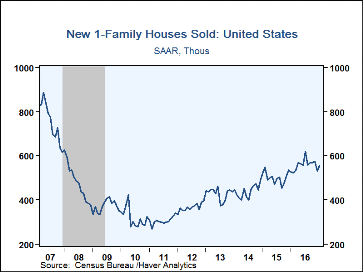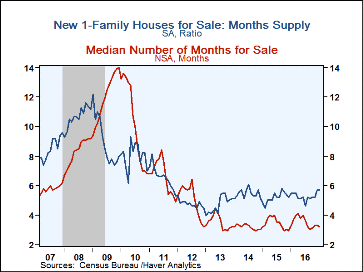 Global| Feb 24 2017
Global| Feb 24 2017U.S. New Home Sales Rebound in January, Though Less than Expected
by:Sandy Batten
|in:Economy in Brief
Summary
Sales of new single-family homes rebounded in January, rising 3.7% m/m to 555,000 units, seasonally adjusted at an annual rate. The sharp 10.4% m/m drop in December was revised up to a 7.0% m/m decline (575,000 units), but this was [...]
Sales of new single-family homes rebounded in January, rising 3.7% m/m to 555,000 units, seasonally adjusted at an annual rate. The sharp 10.4% m/m drop in December was revised up to a 7.0% m/m decline (575,000 units), but this was due mostly to a downward revision to the previously reported 4.7% m/m jump (598,000 units) in November--now a more modest 1.2% m/m rise. The Action Economics Forecast Survey had looked for a rebound, but a slightly larger one than transpired (to 570,000). Compared to a year ago, sales of new homes are up 5.1%. New home sales have more than doubled from their February 2011 low but remain more than 60% below their July 2005 peak. Sales of new homes have generally slowed since the middle of last year, in sharp contrast to the acceleration in the sales of existing homes.
The median price of a new home (NSA) slipped 1.0% m/m (+7.5% y/y) to $312,900 from $316,200, revised from $322,500. The average price of a new home slumped 4.8% m/m (-1.3% y/y) to $360,900 following a 1.9% m/m rise in December and a 9.2% m/m jump in November.
The January rebound in sales was relatively widespread with sales rising in three of the four major regions. Sales jumped 15.8% m/m in the Northeast, soared 14.8% m/m in the Midwest, and increased 4.3% m/m in the South. They slipped 4.4% m/m in the West.
The months' supply of homes at the current sales rate was unchanged in January at 5.7, its highest level since September 2015. The median number of months a new home was on the market edged down to 3.2 (NSA) in January from 3.3 in December and remains significantly below the most recent high of 4.1 months in April.
The data in this report are available in Haver's USECON database. The consensus expectation figure from the Action Economics Forecast Survey is available in the AS1REPNA database.
| U.S. New Single-Family Home Sales (SAAR, 000s) | Jan | Dec | Nov | Jan Y/Y % | 2016 | 2015 | 2014 |
|---|---|---|---|---|---|---|---|
| Total | 555 | 535 | 575 | 5.1 | 560 | 501 | 439 |
| Northeast | 44 | 38 | 30 | 0.0 | 34 | 24 | 28 |
| Midwest | 70 | 61 | 75 | 0.0 | 67 | 61 | 60 |
| South | 290 | 278 | 313 | -4.5 | 318 | 285 | 244 |
| West | 151 | 158 | 157 | 10.0 | 143 | 128 | 108 |
| Median Price (NSA, $) | 312,900 | 316,200 | 315,900 | 7.5 | 308,992 | 297,258 | 283,775 |
Sandy Batten
AuthorMore in Author Profile »Sandy Batten has more than 30 years of experience analyzing industrial economies and financial markets and a wide range of experience across the financial services sector, government, and academia. Before joining Haver Analytics, Sandy was a Vice President and Senior Economist at Citibank; Senior Credit Market Analyst at CDC Investment Management, Managing Director at Bear Stearns, and Executive Director at JPMorgan. In 2008, Sandy was named the most accurate US forecaster by the National Association for Business Economics. He is a member of the New York Forecasters Club, NABE, and the American Economic Association. Prior to his time in the financial services sector, Sandy was a Research Officer at the Federal Reserve Bank of St. Louis, Senior Staff Economist on the President’s Council of Economic Advisors, Deputy Assistant Secretary for Economic Policy at the US Treasury, and Economist at the International Monetary Fund. Sandy has taught economics at St. Louis University, Denison University, and Muskingun College. He has published numerous peer-reviewed articles in a wide range of academic publications. He has a B.A. in economics from the University of Richmond and a M.A. and Ph.D. in economics from The Ohio State University.










